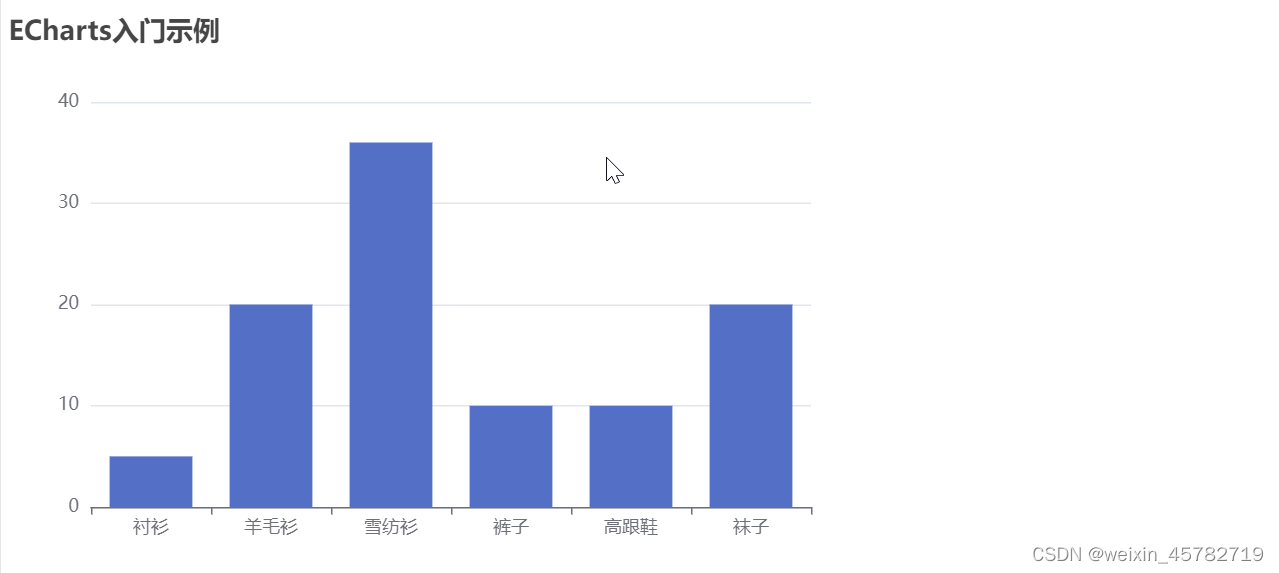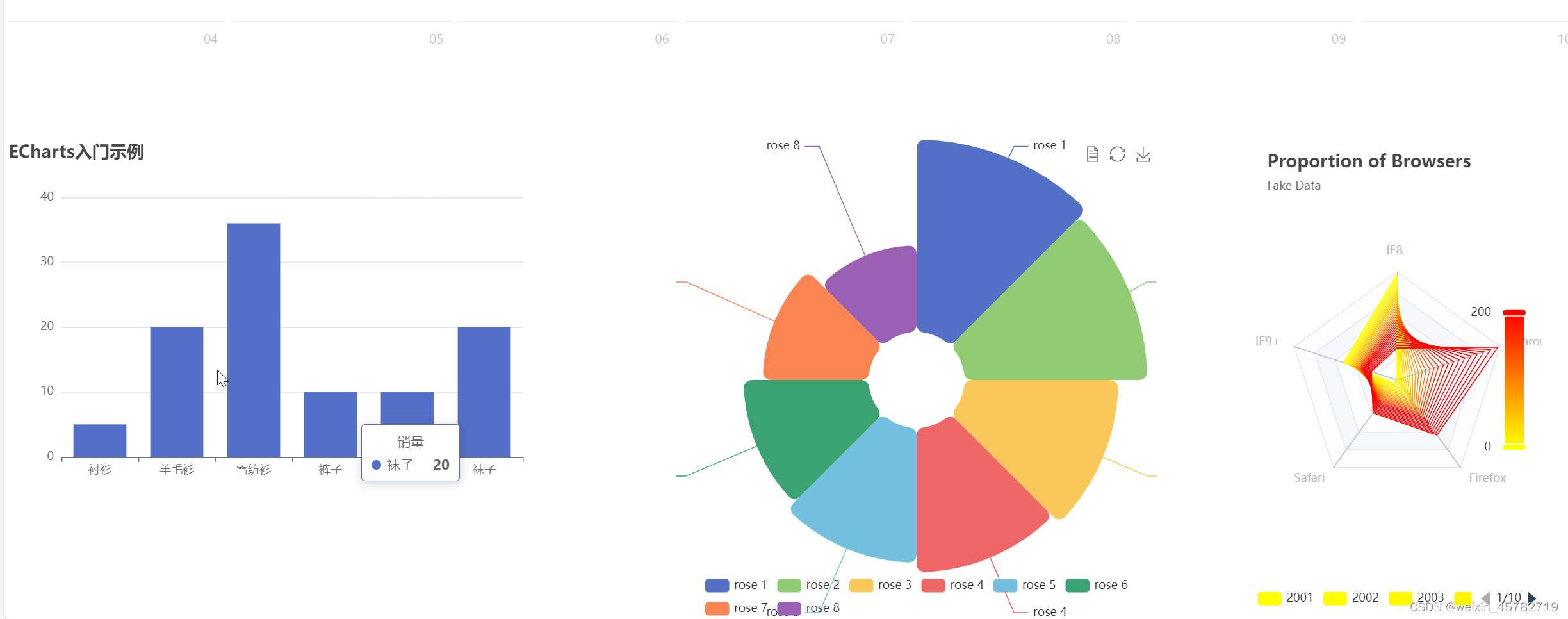图表组件
ECharts,全称为Enterprise Charts,是一个使用JavaScript实现的开源可视化库。它主要用于数据可视化领域,能够方便地创建出直观、交互性强的图表。ECharts由百度团队开发,目前是Apache的顶级项目之一。ECharts支持的图表类型非常丰富,包括但不限于柱状图、折线图、饼图、散点图、雷达图、地图、热力图、树图、桑基图等多种。ECharts的设计哲学是可高度定制化和拓展性好,能够满足多种数据可视化需求。
ECharts的主要特点
- 丰富的图表类型:ECharts提供了丰富的图表类型,能够满足大部分数据可视化需求。
- 高度可定制:用户可以通过配置项自定义图表的各个元素,如色彩、字体、样式等,满足个性化展示需求。
- 良好的交互性:ECharts支持图表的交互操作,如缩放、拖拽、点击等,提高用户体验。
- 强大的性能:利用zrender作为渲染引擎,优化渲染算法,即使是大数据量也能保证较好的性能。
- 多端适应:支持基于HTML5的Web标准,可在PC和移动设备上使用。
- 国际化:ECharts支持多国语言,方便国际化项目使用。
安装命令如下:
cd bingo_web # 注意,客户端安装模块的所有命令,务必在package.json所在目录下操作。
npm config set strict-ssl true
npm install echarts --save --registry=https://registry.npm.taobao.org
安装完成以后,直接可以在src/views/Bingo.vue页面组件中进行使用Echarts基本示例查看效果。
你遇到的错误信息 "Initialize failed: invalid dom." 指示 ECharts 试图在一个无效的 DOM 元素上进行初始化。这个问题通常是因为在试图初始化 ECharts 实例的时候,对应的 DOM 元素还没有被渲染或不可见,导致 ECharts 无法找到这个元素。
在你的代码中的以下部分:
var myChart = echarts.init(document.getElementById('main'));
你试图使用 document.getElementById('main') 来获取 DOM 元素,但在 Vue 应用中并不存在一个 id="main" 的元素。另外,由于你使用了 Vue 组合式API (<script setup> 标签),直接操作 DOM 可能不是最佳实践。
为了解决这个问题,并且以 Vue 的方式来正确地使用 ECharts,你可以按照以下步骤来修改你的代码:
步骤 1: 使用 Vue 引用来访问 DOM 元素
首先,使用 Vue 的 ref 来创建一个引用,而不是使用 document.getElementById。你已经为 div 元素创建了一个引用 echartsDom:
<div ref="echartsDom" style="width: 600px; height: 400px;"></div>
步骤 2: 在合适的生命周期钩子中初始化 ECharts
由于直接在 <script setup> 中执行代码可能会在 DOM 元素准备好之前尝试访问它们,因此你需要确保在 DOM 元素可用时初始化 ECharts 实例。在 Vue 3 中,你可以使用 onMounted 钩子来保证 DOM 已经挂载:
import { onMounted, ref } from 'vue';
const echartsDom = ref(null); // 创建一个 ref
onMounted(() => {
if (echartsDom.value) {
var myChart = echarts.init(echartsDom.value);
// 指定图表的配置项和数据
var option = {
// 配置项...
};
// 使用刚指定的配置项和数据显示图表。
myChart.setOption(option);
}
});
注意:在使用组合式 API 时,通过 ref 创建的引用在模板中使用时不需要 .value,但在 JavaScript 中访问时,需要通过 .value 来获取其真实的 DOM 元素。
完整的修改建议
根据上述步骤修改后,你的 <script setup> 部分应该类似于这样:
import { onMounted, ref } from 'vue';
import * as echarts from 'echarts';
// 其他 import...
const echartsDom = ref(null);
onMounted(() => {
if (echartsDom.value) {
var myChart = echarts.init(echartsDom.value);
var option = {
title: {
text: 'ECharts入门示例'
},
tooltip: {},
xAxis: {
data: ["衬衫","羊毛衫","雪纺衫","裤子","高跟鞋","袜子"]
},
yAxis: {},
series: [{
name: '销量',
type: 'bar',
data: [5, 20, 36, 10, 10, 20]
}]
};
myChart.setOption(option);
}
});
并在 template 部分相应地更新 echartsDom ref 的使用:
<div ref="echartsDom" style="width: 600px; height: 400px;"></div>
执行效果:

例子2
<template>
<h1 class="time">Time</h1>
<div>
<div class="c1">
<ConfigProvider :locale="zhCN">
<!-- 应用的其他内容 -->
<div>
<a-button type="primary" @click="showModal">Open Modal</a-button>
<a-modal v-model:open="open" title="Basic Modal" @ok="handleOk">
<a-form
:model="formState"
name="basic"
:label-col="{ span: 8 }"
:wrapper-col="{ span: 16 }"
autocomplete="off"
@finish="onFinish"
@finishFailed="onFinishFailed"
>
<a-form-item
label="Username"
name="username"
:rules="[{ required: true, message: 'Please input your username!' }]"
>
<a-input v-model:value="formState.username" />
</a-form-item>
<a-form-item
label="Password"
name="password"
:rules="[{ required: true, message: 'Please input your password!' }]"
>
<a-input-password v-model:value="formState.password" />
</a-form-item>
<a-form-item name="remember" :wrapper-col="{ offset: 8, span: 16 }">
<a-checkbox v-model:checked="formState.remember">Remember me</a-checkbox>
</a-form-item>
<a-form-item :wrapper-col="{ offset: 8, span: 16 }">
<a-button type="primary" html-type="submit">Submit</a-button>
</a-form-item>
</a-form>
</a-modal>
</div>
<a-calendar v-model:value="value" @panelChange="onPanelChange" @select="onSelect"></a-calendar>
<router-view/>
</ConfigProvider>
</div>
<div class="c2">
<div ref="echartsDom" style="width: 600px; height: 400px;"></div>
</div>
<div class="c3">
<div class="chart" ref="chart"></div>
</div>
<div class="c4" >
<!-- 在HTML中指定一个容器,用来容纳将要绘制的图表 -->
<div class="drak" ref="dark"></div>
</div>
</div>
</template>
<script setup>
import * as echarts from 'echarts';
import { ConfigProvider } from 'ant-design-vue';
import zhCN from 'ant-design-vue/es/locale/zh_CN';
import {onMounted, ref} from 'vue';
const open = ref(false);
const showModal = () => {
open.value = true;
};
const handleOk = e => {
console.log(e);
open.value = false;
};
import { reactive } from 'vue';
const formState = reactive({
username: '',
password: '',
remember: true,
});
const onFinish = values => {
console.log('Success:', values);
};
const onFinishFailed = errorInfo => {
console.log('Failed:', errorInfo);
};
const value = ref();
const onPanelChange = (value, mode) => {
console.log(value, mode);
};
const echartsDom = ref(null);
/*饼图*/
const chart = ref(null)
let setbing = () =>{
//基于准备好的dom,初始化echarts实例
const myChart1 = echarts.init(chart.value);
var option1;
option1 = {
legend: {
top: 'bottom'
},
toolbox: {
show: true,
feature: {
mark: { show: true },
dataView: { show: true, readOnly: false },
restore: { show: true },
saveAsImage: { show: true }
}
},
series: [
{
name: 'Nightingale Chart',
type: 'pie',
radius: [50, 250],
center: ['50%', '50%'],
roseType: 'area',
itemStyle: {
borderRadius: 8
},
data: [
{ value: 40, name: 'rose 1' },
{ value: 38, name: 'rose 2' },
{ value: 32, name: 'rose 3' },
{ value: 30, name: 'rose 4' },
{ value: 28, name: 'rose 5' },
{ value: 26, name: 'rose 6' },
{ value: 22, name: 'rose 7' },
{ value: 18, name: 'rose 8' }
]
}
]
};
//使用刚指定的配置项和数据显示图表。
option1 && myChart1.setOption(option1);
}
/*3d图*/
const dark = ref()
let ditu = () =>{
var myChart2 = echarts.init(dark.value);
var option2;
option2 = {
title: {
text: 'Proportion of Browsers',
subtext: 'Fake Data',
top: 10,
left: 10
},
tooltip: {
trigger: 'item'
},
legend: {
type: 'scroll',
bottom: 10,
data: (function () {
var list = [];
for (var i = 1; i <= 28; i++) {
list.push(i + 2000 + '');
}
return list;
})()
},
visualMap: {
top: 'middle',
right: 10,
color: ['red', 'yellow'],
calculable: true
},
radar: {
indicator: [
{ text: 'IE8-', max: 400 },
{ text: 'IE9+', max: 400 },
{ text: 'Safari', max: 400 },
{ text: 'Firefox', max: 400 },
{ text: 'Chrome', max: 400 }
]
},
series: (function () {
var series = [];
for (var i = 1; i <= 28; i++) {
series.push({
type: 'radar',
symbol: 'none',
lineStyle: {
width: 1
},
emphasis: {
areaStyle: {
color: 'rgba(0,250,0,0.3)'
}
},
data: [
{
value: [
(40 - i) * 10,
(38 - i) * 4 + 60,
i * 5 + 10,
i * 9,
(i * i) / 2
],
name: i + 2000 + ''
}
]
});
}
return series;
})()
};
option2 && myChart2.setOption(option2);
}
onMounted(() => {
if (echartsDom.value) {
var myChart = echarts.init(echartsDom.value);
var option = {
title: {
text: 'ECharts入门示例'
},
tooltip: {},
xAxis: {
data: ["衬衫","羊毛衫","雪纺衫","裤子","高跟鞋","袜子"]
},
yAxis: {},
series: [{
name: '销量',
type: 'bar',
data: [5, 20, 36, 10, 10, 20]
}]
};
myChart.setOption(option);
}
setbing()
ditu()
});
</script>
<style scoped>
.events {
list-style: none;
margin: 0;
padding: 0;
}
.events .ant-badge-status {
overflow: hidden;
white-space: nowrap;
width: 100%;
text-overflow: ellipsis;
font-size: 12px;
}
.notes-month {
text-align: center;
font-size: 28px;
}
.notes-month section {
font-size: 28px;
}
.chart{
width: 500px;
height: 500px;
float: left;
margin: 0 auto 0 100px;
}
.c1,.c2,.c3,.c4 {
float: left;
}
.drak{
width: 300px;
height: 500px;
float: left;
margin: 0 auto 0 100px;
}
</style>
实现效果:





















 2799
2799











 被折叠的 条评论
为什么被折叠?
被折叠的 条评论
为什么被折叠?








